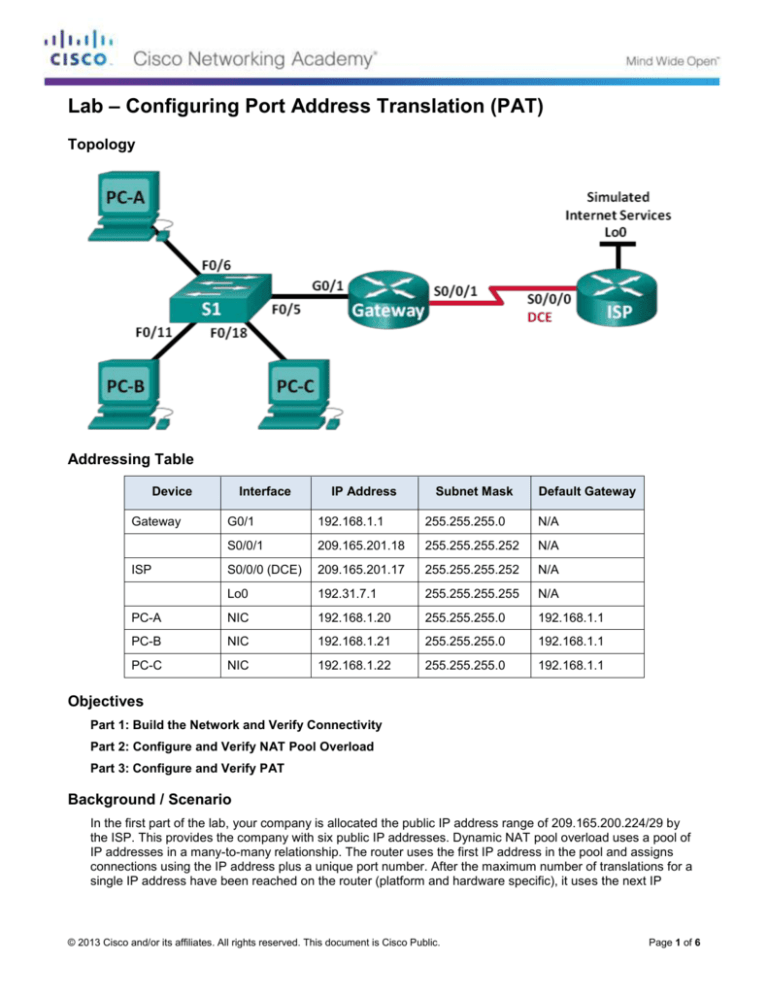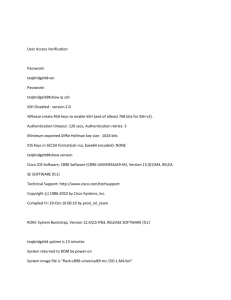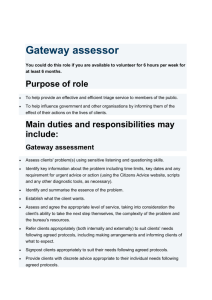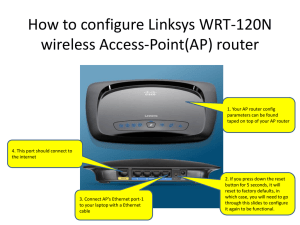
Lab – Configuring Port Address Translation (PAT)
Topology
Addressing Table
Device
Gateway
Interface
IP Address
Subnet Mask
Default Gateway
G0/1
192.168.1.1
255.255.255.0
N/A
S0/0/1
209.165.201.18
255.255.255.252
N/A
S0/0/0 (DCE)
209.165.201.17
255.255.255.252
N/A
Lo0
192.31.7.1
255.255.255.255
N/A
PC-A
NIC
192.168.1.20
255.255.255.0
192.168.1.1
PC-B
NIC
192.168.1.21
255.255.255.0
192.168.1.1
PC-C
NIC
192.168.1.22
255.255.255.0
192.168.1.1
ISP
Objectives
Part 1: Build the Network and Verify Connectivity
Part 2: Configure and Verify NAT Pool Overload
Part 3: Configure and Verify PAT
Background / Scenario
In the first part of the lab, your company is allocated the public IP address range of 209.165.200.224/29 by
the ISP. This provides the company with six public IP addresses. Dynamic NAT pool overload uses a pool of
IP addresses in a many-to-many relationship. The router uses the first IP address in the pool and assigns
connections using the IP address plus a unique port number. After the maximum number of translations for a
single IP address have been reached on the router (platform and hardware specific), it uses the next IP
© 2013 Cisco and/or its affiliates. All rights reserved. This document is Cisco Public.
Page 1 of 6
Lab – Configuring Port Address Translation (PAT)
address in the pool. NAT pool overload is a form port address translation (PAT) that overloads a group of
public IPv4 addresses.
In Part 2, the ISP has allocated a single IP address, 209.165.201.18, to your company for use on the Internet
connection from the company Gateway router to the ISP. You will use the PAT to convert multiple internal
addresses into the one usable public address. You will test, view, and verify that the translations are taking
place, and you will interpret the NAT/PAT statistics to monitor the process.
Note: The routers used with CCNA hands-on labs are Cisco 1941 Integrated Services Routers (ISRs) with
Cisco IOS Release 15.2(4)M3 (universalk9 image). The switches used are Cisco Catalyst 2960s with Cisco
IOS Release 15.0(2) (lanbasek9 image). Other routers, switches and Cisco IOS versions can be used.
Depending on the model and Cisco IOS version, the commands available and output produced might vary
from what is shown in the labs. Refer to the Router Interface Summary Table at the end of this lab for the
correct interface identifiers.
Note: Make sure that the routers and switch have been erased and have no startup configurations. If you are
unsure, contact your instructor.
Required Resources
2 Routers (Cisco 1941 with Cisco IOS Release 15.2(4)M3 universal image or comparable)
1 Switch (Cisco 2960 with Cisco IOS Release 15.0(2) lanbasek9 image or comparable)
3 PCs (Windows 7, Vista, or XP with terminal emulation program, such as Tera Term)
Console cables to configure the Cisco IOS devices via the console ports
Ethernet and serial cables as shown in the topology
Part 1: Build the Network and Verify Connectivity
In Part 1, you will set up the network topology and configure basic settings, such as the interface IP
addresses, static routing, device access, and passwords.
Step 1: Cable the network as shown in the topology.
Step 2: Configure PC hosts.
Step 3: Initialize and reload the routers and switches.
Step 4: Configure basic settings for each router.
a. Disable DNS lookup.
b. Configure IP addresses for the routers as listed in the Addressing Table.
c.
Set the clock rate to 128000 for DCE serial interface.
d. Configure device name as shown in the topology.
e. Assign cisco as the console and vty passwords.
f.
Assign class as the encrypted privileged EXEC mode password.
g. Configure logging synchronous to prevent console messages from interrupting the command entry.
Step 5: Configure static routing.
a. Create a static route from the ISP router to the Gateway router.
ISP(config)# ip route 209.165.200.224 255.255.255.248 209.165.201.18
© 2013 Cisco and/or its affiliates. All rights reserved. This document is Cisco Public.
Page 2 of 6
Lab – Configuring Port Address Translation (PAT)
b. Create a default route from the Gateway router to the ISP router.
Gateway(config)# ip route 0.0.0.0 0.0.0.0 209.165.201.17
Step 6: Verify network connectivity.
a. From the PC hosts, ping the G0/1 interface on the Gateway router. Troubleshoot if the pings are
unsuccessful.
b. Verify that the static routes are configured correctly on both routers.
Part 2: Configure and Verify NAT Pool Overload
In Part 2, you will configure the Gateway router to translate the IP addresses from the 192.168.1.0/24 network
to one of the six usable addresses in the 209.165.200.224/29 range.
Step 1: Define an access control list that matches the LAN private IP addresses.
ACL 1 is used to allow the 192.168.1.0/24 network to be translated.
Gateway(config)# access-list 1 permit 192.168.1.0 0.0.0.255
Step 2: Define the pool of usable public IP addresses.
Gateway(config)# ip nat pool public_access 209.165.200.225
netmask 255.255.255.248
209.165.200.230
Step 3: Define the NAT from the inside source list to the outside pool.
Gateway(config)# ip nat inside source list 1 pool public_access overload
Step 4: Specify the interfaces.
Issue the ip nat inside and ip nat outside commands to the interfaces.
Gateway(config)# interface g0/1
Gateway(config-if)# ip nat inside
Gateway(config-if)# interface s0/0/1
Gateway(config-if)# ip nat outside
Step 5: Verify the NAT pool overload configuration.
a. From each PC host, ping the 192.31.7.1 address on the ISP router.
b. Display NAT statistics on the Gateway router.
Gateway# show ip nat statistics
Total active translations: 3 (0 static, 3 dynamic; 3 extended)
Peak translations: 3, occurred 00:00:25 ago
Outside interfaces:
Serial0/0/1
Inside interfaces:
GigabitEthernet0/1
Hits: 24 Misses: 0
CEF Translated packets: 24, CEF Punted packets: 0
Expired translations: 0
Dynamic mappings:
© 2013 Cisco and/or its affiliates. All rights reserved. This document is Cisco Public.
Page 3 of 6
Lab – Configuring Port Address Translation (PAT)
-- Inside Source
[Id: 1] access-list 1 pool public_access refcount 3
pool public_access: netmask 255.255.255.248
start 209.165.200.225 end 209.165.200.230
type generic, total addresses 6, allocated 1 (16%), misses 0
Total doors: 0
Appl doors: 0
Normal doors: 0
Queued Packets: 0
c.
Display NATs on the Gateway router.
Gateway# show ip nat translations
Pro Inside global
icmp 209.165.200.225:0
icmp 209.165.200.225:1
icmp 209.165.200.225:2
Inside local
192.168.1.20:1
192.168.1.21:1
192.168.1.22:1
Outside local
192.31.7.1:1
192.31.7.1:1
192.31.7.1:1
Outside global
192.31.7.1:0
192.31.7.1:1
192.31.7.1:2
Note: Depending on how much time has elapsed since you performed the pings from each PC, you may
not see all three translations. ICMP translations have a short timeout value.
How many Inside local IP addresses are listed in the sample output above? ______________
How many Inside global IP addresses are listed? ______________
How many port numbers are used paired with the Inside global addresses? ______________
What would be the result of pinging the Inside local address of PC-A from the ISP router? Why?
____________________________________________________________________________________
____________________________________________________________________________________
Part 3: Configure and Verify PAT
In Part 3, you will configure PAT by using an interface instead of a pool of addresses to define the outside
address. Not all of the commands in Part 2 will be reused in Part 3.
Step 1: Clear NATs and statistics on the Gateway router.
Step 2: Verify the configuration for NAT.
a. Verify that statistics have been cleared.
b. Verify that the outside and inside interfaces are configured for NATs.
c.
Verify that the ACL is still configured for NATs.
What command did you use to confirm the results from steps a to c?
____________________________________________________________________________________
Step 3: Remove the pool of useable public IP addresses.
Gateway(config)# no ip nat pool public_access 209.165.200.225 209.165.200.230
netmask 255.255.255.248
© 2013 Cisco and/or its affiliates. All rights reserved. This document is Cisco Public.
Page 4 of 6
Lab – Configuring Port Address Translation (PAT)
Step 4: Remove the NAT translation from inside source list to outside pool.
Gateway(config)# no ip nat inside source list 1 pool public_access overload
Step 5: Associate the source list with the outside interface.
Gateway(config)# ip nat inside source list 1 interface serial 0/0/1 overload
Step 6: Test the PAT configuration.
a. From each PC, ping the 192.31.7.1 address on the ISP router.
b. Display NAT statistics on the Gateway router.
Gateway# show ip nat statistics
Total active translations: 3 (0 static, 3 dynamic; 3 extended)
Peak translations: 3, occurred 00:00:19 ago
Outside interfaces:
Serial0/0/1
Inside interfaces:
GigabitEthernet0/1
Hits: 24 Misses: 0
CEF Translated packets: 24, CEF Punted packets: 0
Expired translations: 0
Dynamic mappings:
-- Inside Source
[Id: 2] access-list 1 interface Serial0/0/1 refcount 3
Total doors: 0
Appl doors: 0
Normal doors: 0
Queued Packets: 0
c.
Display NAT translations on Gateway.
Gateway# show ip nat translations
Pro Inside global
icmp 209.165.201.18:3
icmp 209.165.201.18:1
icmp 209.165.201.18:4
Inside local
192.168.1.20:1
192.168.1.21:1
192.168.1.22:1
Outside local
192.31.7.1:1
192.31.7.1:1
192.31.7.1:1
Outside global
192.31.7.1:3
192.31.7.1:1
192.31.7.1:4
Reflection
What advantages does PAT provide?
_______________________________________________________________________________________
_______________________________________________________________________________________
© 2013 Cisco and/or its affiliates. All rights reserved. This document is Cisco Public.
Page 5 of 6
Lab – Configuring Port Address Translation (PAT)
Router Interface Summary Table
Router Interface Summary
Router Model
Ethernet Interface #1
Ethernet Interface #2
Serial Interface #1
Serial Interface #2
1800
Fast Ethernet 0/0
(F0/0)
Fast Ethernet 0/1
(F0/1)
Serial 0/0/0 (S0/0/0)
Serial 0/0/1 (S0/0/1)
1900
Gigabit Ethernet 0/0
(G0/0)
Gigabit Ethernet 0/1
(G0/1)
Serial 0/0/0 (S0/0/0)
Serial 0/0/1 (S0/0/1)
2801
Fast Ethernet 0/0
(F0/0)
Fast Ethernet 0/1
(F0/1)
Serial 0/1/0 (S0/1/0)
Serial 0/1/1 (S0/1/1)
2811
Fast Ethernet 0/0
(F0/0)
Fast Ethernet 0/1
(F0/1)
Serial 0/0/0 (S0/0/0)
Serial 0/0/1 (S0/0/1)
2900
Gigabit Ethernet 0/0
(G0/0)
Gigabit Ethernet 0/1
(G0/1)
Serial 0/0/0 (S0/0/0)
Serial 0/0/1 (S0/0/1)
Note: To find out how the router is configured, look at the interfaces to identify the type of router and how many
interfaces the router has. There is no way to effectively list all the combinations of configurations for each router
class. This table includes identifiers for the possible combinations of Ethernet and Serial interfaces in the device.
The table does not include any other type of interface, even though a specific router may contain one. An
example of this might be an ISDN BRI interface. The string in parenthesis is the legal abbreviation that can be
used in Cisco IOS commands to represent the interface.
© 2013 Cisco and/or its affiliates. All rights reserved. This document is Cisco Public.
Page 6 of 6









